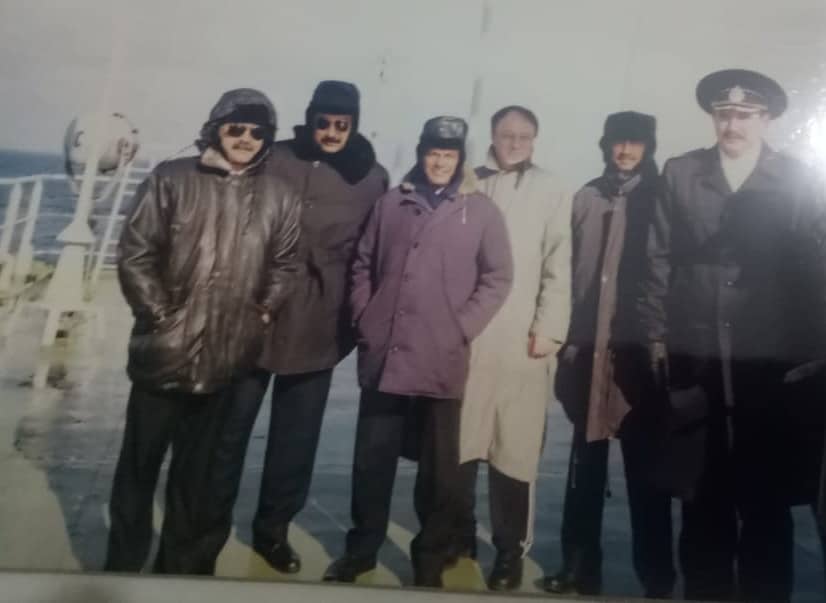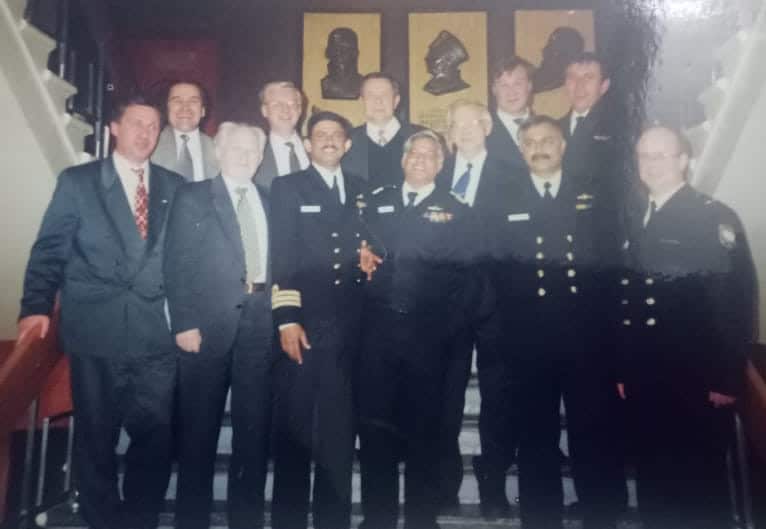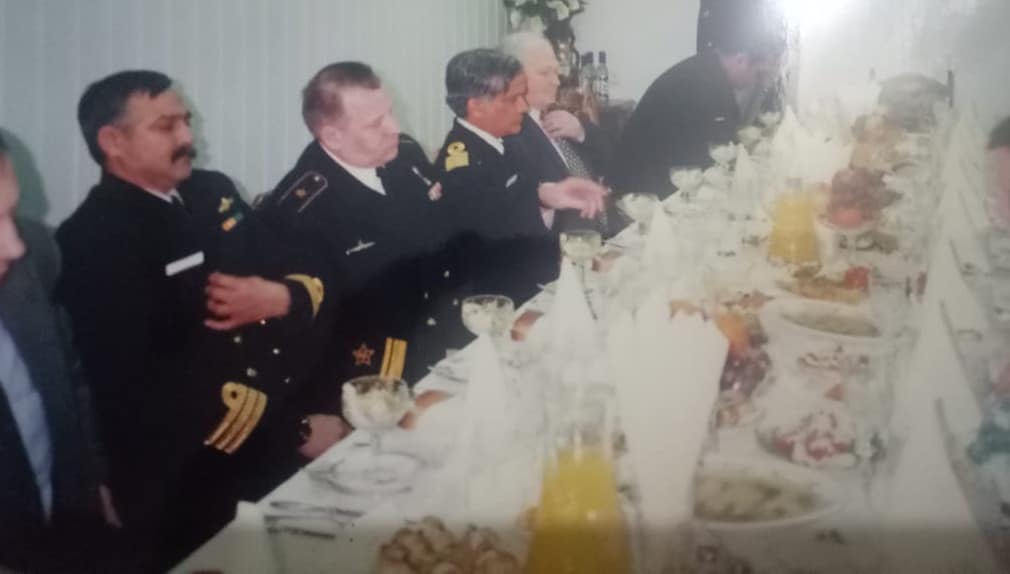In Nov 1997, the Indian Navy had entered into a contract to acquire Two Kilo-class 877 EKM submarines, with the Russian federation. The first of the two, INS Sindhurakshak was to be delivered within four months and the second, INS Sindhushastra was to be delivered in 30 months with a capability to launch and equipped with Klub 3M-54 anti-ship cruise missile.
As the Principal Director Submarine Acquisition (PDSMAQ), I was deputed to Russia (Severomorsk, HQ of the Northern Fleet of the Russian Navy) in April 2000 to witness the acceptance firing of the missile from a Russian submarine. Prior to that, I had gone to Visakhapatnam to shift my family to New Delhi, after my son had completed the 10th Secondary Board examinations. During this visit, I had the opportunity to meet my old friend Mr SN Sharma, who was the Senior Inspector of Naval Armament (SINA) at Visakhapatnam. He also used to practice astrology as a side hobby. During our discussions, I told him that I was to go to Russia soon after my move to Delhi for the acceptance firing of the Klub anti-ship missile from a submarine. He looked at my hand and said that he did not see me making any foreign trip in the immediate. I then told him that I was already booked to fly to Moscow on the 13th of April. He then said that though I may fly but the aim of the trip was unlikely to be achieved before the 25th of April. I took the information with a bit of scepticism and bid my farewell to him.

Soon after reaching Delhi with my family on the 10th April, I flew out on the night 12/13 April and reached Moscow via Paris on the night of 13th April. After spending two days in Moscow for a briefing by Cmde PS Sahi, the Naval Attache, I left for Murmansk with Cdr S Lal, the DNA and the representatives of Rosoboronexport (ROE), my old friends Mr Valera Eferemov and Mr Valera Manuelivich. On arrival in the afternoon of 15th April, we settled down at Hotel Arctica. There I met up with the rest of the Indian team, which was also to witness the firing. This team comprised of the Captains of Sindhuraj (JS Malik), Sindhukesari (Sahu), which were undergoing medium refit in St Petersburg. Cdr. Rajesh Sarin, the CO designate of Sindhushastra was also there in the in addition to the XOs and the Weapons officer of each boat.
The next two days were spent driving each morning down to Severomorsk for briefing and seeing some other establishments such as the submarine museum of the boat K21 and the Deep Submergence Rescue Vessel (DSRV) ‘Bester’ which the Russians were proposing to the Indian Navy. I was most amused on seeing the Bester. It had been hurriedly prepared so much so that the gangway leading up to it was still wet with fresh paint and the vessel itself did not have any designated places for the evacuees from a distressed submarine to sit. Needless to say that I was not impressed with it as it was far short of meeting the requirements of the Indian Navy. Anyhow, it was not the main objective of my visit.
During the briefing, I along with my team was introduced to the General Director, of the firm manufacturing the missile ‘Novator’, Mr Pavel Ivanovich Kamnev. He was decorated with the highest medal for labour in Russia, ‘Geroi tryda’ for his contribution in the development of missiles. Incidentally, the famous Kalibr land attack missile used so effectively in the Syrian conflict is also the handiwork of Mr Kamnev. Besides him, we also met Mr Evgeny Novikov and Mr Gavrlikov, two scientists associated in the development of the Klub anti-ship missile. However, the most important personality in our interaction with the Russian side was Vice-Admiral Mikhail Nikolaevich Motsak, the Chief of staff of the Northern Fleet Headquarters. The ROE had deputed a young sub-lieutenant from their navy to me as an interpreter. However, despite having visited the Soviet Union last in Jan 1991, my knowledge of the Russian language was intact and I realized that I could do a better job, as the young man was not very conversant with the technical vocabulary. So his services were utilized more for liaison functions. Our request to embark the firing submarine was not acceded to as it was a Soviet nuclear-powered submarine and we did not have the necessary clearance. We were to embark a survey ship to witness the firing. A large number of surface and air units were utilized to ensure range clearance for the firing in the Barent’s Sea. The target was positioned at a range of 160 km and we were to satisfy ourselves with real-time telemetry data from the sensors deployed on the missile as well as on an aircraft tracking the missile.

We sailed out on the night of 19th April and were in the firing area early next morning. The firing was scheduled at 1100 h on the 20th April, but the weather was not conducive and we had to wait till the next morning. The sun was out bright on 21st April and all systems were ‘go’. The hydrographic ship that we were embarked on was stationed about 10 cables (1 nm) abaft of the firing position of the submarine, which was in a dived state. The launch was ordered exactly at 1100 h and we waited with bated breaths for the missile to break the surface and climb to its cruise trajectory but nothing was seen to our utter surprise. There was a stunned silence on the part of our Russian colleagues and after an hour we were asked to shape course back to Severomorsk and entered harbour later the same evening and proceeded to Murmansk for the night. We were to assemble the next morning at the Northern Fleet HQ at 1100 h. The drive from Murmansk used to take about 45 minutes.
We knew that something had gone terribly wrong and so in the evening we drank our sorrows in the restaurant in the Arctik hotel. Questions posed to Eferemov and Manuelivich went unanswered. Perhaps, even they were not privy to what had transpired. Though with my experience I suspected that the missile had ditched soon after it had left the torpedo tube. That evening all of us let the circumstances be as they were and decided to enjoy the music of the band in the hotel. An anecdote is worth recalling. In Russia, if one wants the band to play a request, money has to be paid to them by tradition. However, if one were to sing with the band, then the protocol was not known. I sang a few English and Russian songs with the band. At the end of the evening, the leader of the band approached me to ask for money (a couple of Hundred Rubles). I retorted that it was he who should pay me for having sung the songs. However, the difference in opinion was soon resolved with us agreeing to pay to keep the spirit of the Indo-Russian friendship.
The next morning we set off to attend the debrief. At the specified time of 1100 hours, all of us were seated in the conference hall. The sonar operator from the firing submarine was there to give his report. He started with aplomb and waxed eloquent as to how after the missile had left the torpedo tube, he had acquired it on the sonar and was tracking the missile HE traversing through the water and that he continued to track it for a great distance till he lost contact. Some of my younger colleagues were not amused and wanted to interrupt but I refrained them. After the sonar operator had finished his report, I asked him “Skolko tebe let’ Meaning ‘How old are you?’ He replied that he was getting to be 19 years in age. I then told him “Tbi dumaesh, shto ya durak? Y menja opitb na gak pochti ravno tvoi vosrasti”. “Do you take me to be a fool? My experience in sonars is nearly equal to your age. “Tbi verish shto raketa mozhet letatb podvodoi? “Do you believe that a missile can fly underwater?” Poor chap, he was flummoxed and could not reply. At this stage, the Rear Admiral who was chairing the session stopped the debrief and went to inform the Chief of Staff, VADM Motsak, who came and invited us to lunch as the table had been laid. The poor operator was shivering in fear on seeing the Admiral who ignored him. I am quite sure that later on he would have been subjected to a proper dressing down.

The table was laid for a sumptuous lunch, which started at 1230 h and went on till 1730 h in the evening. A lot many toasts were raised, which included on Indo-Russian friendship, to good fortune, to love, to luck, to submariners and so on. We also sang the submarine anthem of the Russian Navy “Ustalaya Podlodka” (Tired Submarine) and a host of Russian folk songs. Songs from the movies of Raj Kapoor were also sung. At the end of the evening, Admiral Motsak announced that there would be a repeat firing as soon as possible. He then presented me with his submarine commanding officers badge saying that it was an honour for him to give it to a “Nastoyashie Podvodnik”, a truly professional submariner. I gave him my Dolphin echoing the sentiment. He was truly a gentleman, who regretfully passed away a year back. I wish his soul eternal peace.

Pavel Ivonovich Kamnev assured me that a replacement missile was already on transit from Ekatrinburg (HQ of Novator) and would be there in three days and the very next day a repeat firing would be scheduled. True to his word the replacement article arrived Severomorsk on 24th and the very next day we sailed out for the firing scheduled for 1100 h on the 26th April. Whilst waiting for the serial to start I could see some anxiety on Eferemov’s face but I was calm and expected the firing to be successful. The launch was ordered and executed at exactly 1100 h and within seconds we saw the missile breaking the sea surface and boost up to the required altitude before settling down on its cruise trajectory. Soon it was out of sight but later on, we were given the telemetry recordings from the tracking aircraft and from the telemetry data transmitted from the equipment on the missile, which confirmed the successful flight of the missile to the target. We were also shown the pictures of the hit on the target with the date and time recordings on it, which tallied with the telemetry data. We all celebrated the occasion by raising champagne toasts in the wardroom of the hydrographic ship on transit back to Severomorsk, where we entered in the late afternoon. The next morning after the debrief we said our farewells to the team of Northern Fleet and Admiral Motsak and left in the afternoon for St Petersburg. The next four days, I spent in St Petersburg to interact with the Submarine design bureau ‘Rubin’ and to review the progress of the medium refit of Sindhuraj and Sindhukesari at the Admiralty shipyard. At Rubin, I had the honour and privilege to interact with Academician Igor Spassky, the famous submarine designer.
I arrived in Moscow on 2nd May a day after the International Labour Day (01 May) and the next few days were spent in meetings at the Office of the Naval Attache and the ROE after which I headed back to Delhi. On reaching there I submitted my report to the VCNS recommending acceptance of the missile into the Indian Navy.
In the debrief at the Northern Fleet HQ on the 27th morning, I told Admiral Motsak that I was confident that we will meet with success in the repeat firing. He asked me for the reason and I narrated to him the conversation I had with Mr. SN Sharma in Visakhapatnam before my visit. He asked “Why did you not tell us before so that we could have saved the time and effort and scheduled the firing on the 26th April in the first instance?” My answer was that I wanted to check if the prediction of Mr. Sharma would turn out to be correct. In doing so I was only following the age old Russian idiom “Doveryai no proveryai.” ‘Believe but verify.’ He laughed and laughed.
